They say it takes two to tango. Find out how two closely-orbiting stellar pairs create fireworks you can see in your own backyard telescope.
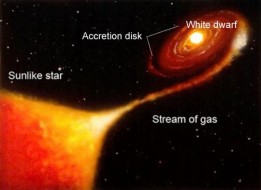
NASA
Nature invented fireworks and has evolved countless ways to light the fuse. Some of the most violent cataclysms occur in binary systems where a small, fantastically dense object like a white dwarf, neutron star, or black hole forms a close pair with a larger, cooler star. The massive object siphons gas from its hapless companion, surrounding itself in a swirling accretion disk.
As material from the cooler star streams into the disk or funnels from the disk to the surface of the compact object, several things can happen, all of which involve spectacular releases of energy.
With many white dwarfs, gas piles up in the accretion disk until it's dumped onto the white dwarf. As the material plunges toward the surface, the release of gravitational potential energy heats the disk to glowing, and visual observers witness a sudden brightening of the system called an outburst. Outbursts of 4 or 5 magnitudes are fairly common among these cataclysmic variable stars, better known as dwarf novae. They last about a week and occur at least several times a year. Frictional heating as the swirls of captured gas work their way from outer to inner edge can also cause a sudden brightening of the system.
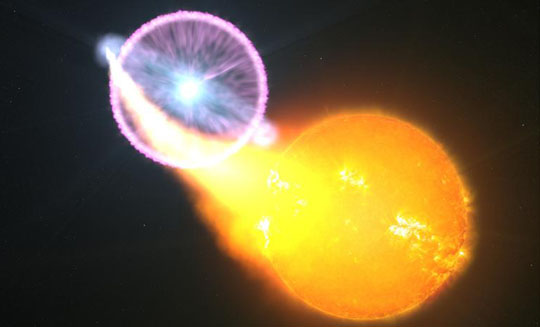
S. Wiessinger / NASA Goddard Space Flight Center
Material that accumulates on the dwarf over thousands of years can become so compacted and heated that it ignites in a thermonuclear fusion called a nova. It's thought that many dwarf novae undergo nova outbursts over the long haul.
Similar events transpire at neutron stars. Gas robbed from the reluctant "donor" star is drawn into an accretion disk around the compact star. Friction between the gas in neighboring regions of the disk can drive up temperatures to millions of degrees, releasing copious amounts of X-rays as well as visual light.
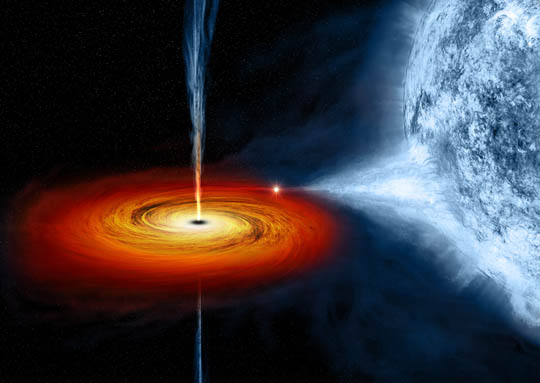
NASA / CXC / M.Weiss
As the densest form of matter imaginable, black holes harbor tremendous gravitational force. In a black hole, material is compressed and heated by friction as it spirals down toward the event horizon, the point of no return. Vast amounts of energy are released across the electromagnetic spectrum, especially in the powerful X-ray region. Sometimes we see flaring and flickering in real time as the rate of flow or amount of material streaming into the hole's gravitational maw varies from moment to moment. If a dwarf nova's a firecracker, a black hole binary's a hundred cherry bombs.
Thanks to observations made across the spectrum using both ground and orbiting telescopes, we know such violent events are common in our cosmos. The trick is finding targets bright enough to examine in amateur telescopes. Fortunately, there are several.
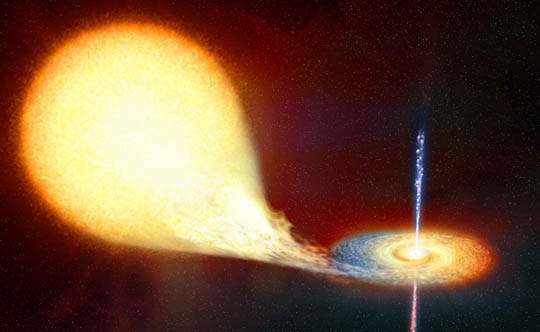
ESA/Hubble
I've selected three examples visible in late summer and early fall that are bright enough to show in 6- to 10-inch telescopes and show easily detectable light fluctuations: the black hole X-ray binary in V4641 Sagittarii; the famed neutron star binary Scorpius X-1 (V818 Scorpii); and the dwarf nova SS Cygni.
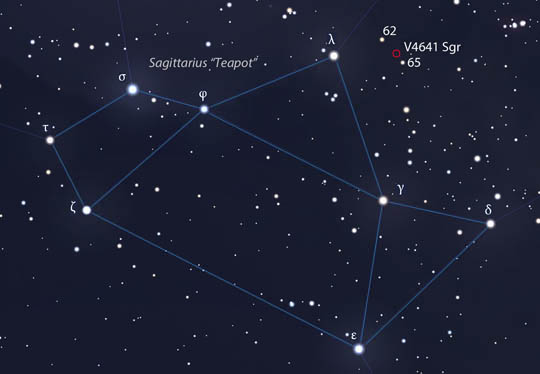
V4641 Sgr, which normally hovers around magnitude +13.6, will require a 10-inch or larger telescope, unless you happen to catch in the midst of a powerful flare like astronomers did in 1999 when it shot up to magnitude +8.8! Astronomers think the tremendous outpouring of radiation was caused by material in the accretion disk plummeting to the fringe of the black hole's event horizon. Amazing that even a modest Dobsonian can see the flickerings of this matter muncher across a distance of 24,000 light-years.
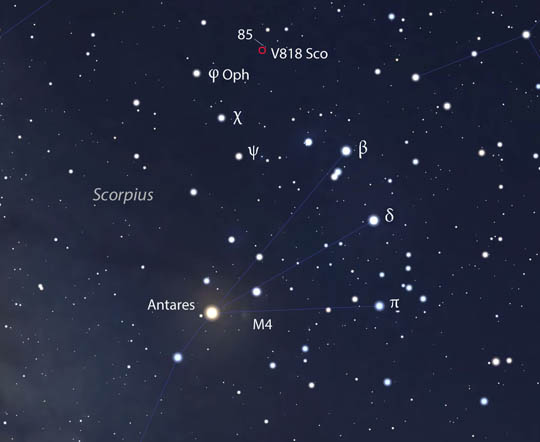
Stellarium
Scorpius X-1 or V818 Scorpii, a neutron star paired with a low-mass (just 0.4 solar) star, outshines every X-ray source in the sky except the Sun and ranges from about magnitude +11.9 at maximum to +12.8 at minimum. Located 9,000 light-years away in the constellation Scorpius, it was the first X-ray source discovered outside of the Solar System. While you'll need time to catch an outburst of V4641 Sgr, V818 Sco variations occur more frequently, requiring only about a week of regular observation to spot a flare or fade.
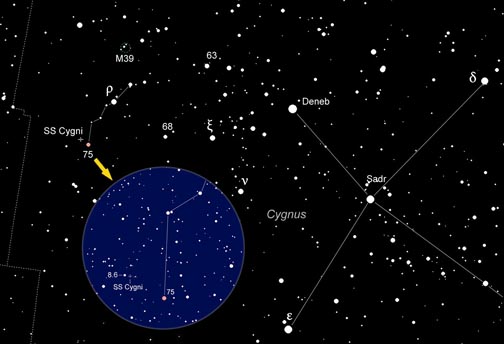
Chris Marriott's SkyMap
SS Cygni, a dwarf nova and favorite of variable star observers, is the easiest of the three, with a range from 8th magnitude in outburst to 12th in quiescence. Even a 4-inch telescope will suffice to follow its antics. I've watched this star for years; when caught in outburst, it always puts me in a good mood, like pulling that prize from a box of Cracker Jack. Expect an eruption about every 40 days, when the slumbering system leaps four magnitudes in one or two nights. What a sight!
Detailed maps for all three of our featured stars can be freely downloaded from the American Association of Variable Star Observers (AAVSO) website. Type the star name in the Pick a Star box and then click on the Create a Finder Chart link to create a customized chart. Or, you can use my direct links: V4641 Sagittarii (high magnification), V4641 Sagittarii (low magnification), V818 Scorpii, SS Cygni. All are oriented with south up.
AAVSO'ers love watching the ups and downs of these and hundreds of other variable stars. They say not much changes in the heavens, but the closer you look, the more alive the sky becomes.
Find your way through the night sky with Sky Atlas 2000.0!
 0
0









Comments
You must be logged in to post a comment.